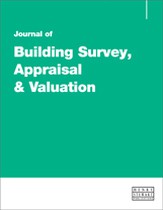Consequential loss in dilapidations : Direct and indirect consequences of consequential loss claims
Abstract
This paper considers the impact and relevance of consequential losses in commercial property claims. As with all civil claims relating to property, the amount of damages sought should be a reflection of the claimant’s loss as a result of the breaches of covenant. In some instances, this is much more than the cost of the works required to remedy any physical breaches of contract. By the same token, due to the effect of section 18(1) of the Landlord and Tenant Act 1927, the loss can be significantly less than the cost of works. This is because section 18(1) seeks to limit damages for breaches of repairing obligations in leases to the impact of those breaches on the value of the landlord’s interest under consideration, be it leasehold or freehold. Further, section 18(1) introduces the concept of supersession whereby the cost of remedying a breach of contract is negated by the subsequent actions of the landlord. For example, the cost of remedying cracking in an internal partition wall is rendered nugatory if the same wall is subsequently demolished by the landlord. The cracking is irrelevant and no loss has been suffered. Whereas the preparation of a schedule of dilapidations is an essential first step in calculating the claimant’s loss, the cost of works arrived at through the costed schedule should be seen as exactly that — an essential first step. Consideration also needs to be given to whether the scheduled works are actually representative of the consequences of the breaches on the value of the interest. This will entail looking at the likely future of the building following the end of any tenancies, the state of the property market at the time those tenancies end and in particular whether rental levels are stable, volatile or somewhere in between. In many instances, this will involve discussion with practitioners in other disciplines associated with the property cycle. As important as the consideration of valuation, diminution and supersession to the assessment of loss is the analysis of the many different areas in which consequential losses may apply. These are complicated and potentially taxing areas but are no less relevant to the calculations of loss as those posed by the principles expressed by section 18(1). This paper seeks to explore the principles surrounding consequential losses so that practitioners will have an understanding to enable them to consider the types and magnitude of those applying to their various situations.
The full article is available to subscribers to the journal.
Author's Biography
Edward Shaw qualified as a Chartered Building Surveyor in 1988 and has specialised in the regulatory side of building surveying for over 30 years. His practice focuses on Landlord and Tenant Law and contractual relationships governing the construction, alteration, maintenance, repair and decoration of property. He spends much of his time dealing with dilapidations disputes and related matters and is passionate about the use and promotion of dispute resolution and ADR in all of its various guises. He has chaired the RICS Dilapidations Steering Group and was instrumental in setting up the RICS Dilapidations Forum, chairing the initial steering group and the first RICS Dilapidations Conference.
Kate Poole is a partner in the London Real Estate Litigation team at DLA Piper. Kate has a broad practice encompassing many aspects of real estate disputes, with a particular focus on contentious development and energy. Kate acts for a wide range of real estate clients, including developers, institutional investors, corporate tenants and financial institutions. Kate has been involved in a number of leading cases in the High Court, Court of Appeal and Privy Council.
Citation
Shaw, Edward and Poole, Kate (2023, December 1). Consequential loss in dilapidations : Direct and indirect consequences of consequential loss claims. In the Journal of Building Survey, Appraisal & Valuation, Volume 12, Issue 3. https://doi.org/10.69554/RLDI5797.Publications LLP
